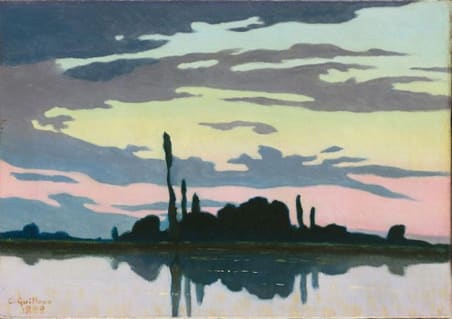
CHARLES GUILLOUX
Literature
J.D. JUMEAU-LAFOND, Les peintres de l’âme, le symbolisme idéaliste en France, exh . cat. Brussels : Ixelles Museum, Oct.-Dec. 1999, DZ Pandora, 1999. See Charles Guilloux, pp 73 - 75.
Fred LEEMAN, Paysages de l’Âme,paysages symbolistes français 1880 – 1910, exh. cat. Gemeentemuseum, The Hague, Oct. 19th, 2010 – Jan. 30th, 2011, pp.43 - 55.
A self-taught artist, Charles Guilloux entered the Society of Independents in 1891. Quickly noticed by Roger Marx, he participated in all the Symbolist and Impressionnist exhibitions at the Le Barc de Boutteville Gallery. Furthermore, he exhibited in the Idealist Salon for Art (Antwerp 1893), at the Durant-Ruel Gallery in Paris (1901), and in 1896, André Mellerio included him in painting in his Idealist Movement. Critics were enthusiastic about his works with their sinuous synthetic forms and rhythms of suggestive dazzling colors. Very rapidly, his painting titles became more and more elliptical, thus confirming their Symbolist dimension: Andante, Adagio, Lactic Calm, Lunar Scherzo, etc.
In keeping with the painting, Twilight (FIG. 1) conserved in the Orsay Museum, our small oil on paper is a beautiful example of the artist’s Nabi period: between sky and water, a band of land barely emerges on which a few dark silhouettes of trees stand out against the horizon. The critic Jules Christophe’s description of these oniric landscapes seems perfectly adapted to our work: "dreamt landscapes, nothing but water, skies, trees, without any "fabrication," without any other being."
All the symbolic force seems to reside in this monochromatic blue cameo suggesting a night lit by the full moon. The clouds’ shadows become fantastical tentacles scattering the sky with mysterious zebra stripes, like an aurora borealis.
Charles Saunier concluded an article in the Revue encyclopédique (1896) by affirming that, "a vision by Charles Guilloux is unforgettable."

FIG. 1 - Twilight, 1892, Oil on canvas, 32 x 46 cm.
© RMN-Grand Palais (Musée d’Orsay) / Hervé Lewandowski.
